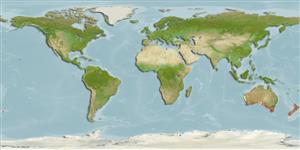Environment: milieu / climate zone / depth range / distribution range
Ecology
Marine; brackish; demersal; depth range 5 - 50 m (Ref. 9563). Temperate
Indo-West Pacific: southern Australia and New Zealand (Ref. 5755).
Size / Weight / Age
Maturity: Lm ? range ? - ? cm
Max length : 30.0 cm TL male/unsexed; (Ref. 9563)
Found on rocky bottoms (Ref. 9563). Known in shallow estuaries from muddy environments to offshore reefs in kelp reef (Ref. 9002). Nocturnal species and juveniles are occasionally seen in large rock pools. Feeds on a wide variety of invertebrates, mainly on crustaceans and fishes (Ref. 9003).
Life cycle and mating behavior
Maturity | Reproduction | Spawning | Eggs | Fecundity | Larvae
May, J.L. and J.G.H. Maxwell, 1986. Trawl fish from temperate waters of Australia. CSIRO Division of Fisheries Research, Tasmania. 492 p. (Ref. 9563)
IUCN Red List Status (Ref. 130435: Version 2024-2)
Human uses
Tools
Special reports
Download XML
Internet sources
Estimates based on models
Preferred temperature (Ref.
123201): 14.7 - 22.3, mean 17.8 °C (based on 132 cells).
Phylogenetic diversity index (Ref.
82804): PD
50 = 0.5000 [Uniqueness, from 0.5 = low to 2.0 = high].
Bayesian length-weight: a=0.01230 (0.00732 - 0.02067), b=3.04 (2.90 - 3.18), in cm total length, based on LWR estimates for this species & Genus-body shape (Ref.
93245).
Trophic level (Ref.
69278): 4.0 ±0.66 se; based on food items.
Resilience (Ref.
120179): Medium, minimum population doubling time 1.4 - 4.4 years (Preliminary K or Fecundity.).
Fishing Vulnerability (Ref.
59153): Low vulnerability (20 of 100).
Nutrients (Ref.
124155): Calcium = 48.4 [23.4, 103.2] mg/100g; Iron = 0.379 [0.204, 0.683] mg/100g; Protein = 18.5 [16.9, 20.0] %; Omega3 = 0.98 [0.42, 2.70] g/100g; Selenium = 9.57 [4.46, 22.24] μg/100g; VitaminA = 22.3 [7.7, 64.0] μg/100g; Zinc = 0.703 [0.497, 1.010] mg/100g (wet weight);
